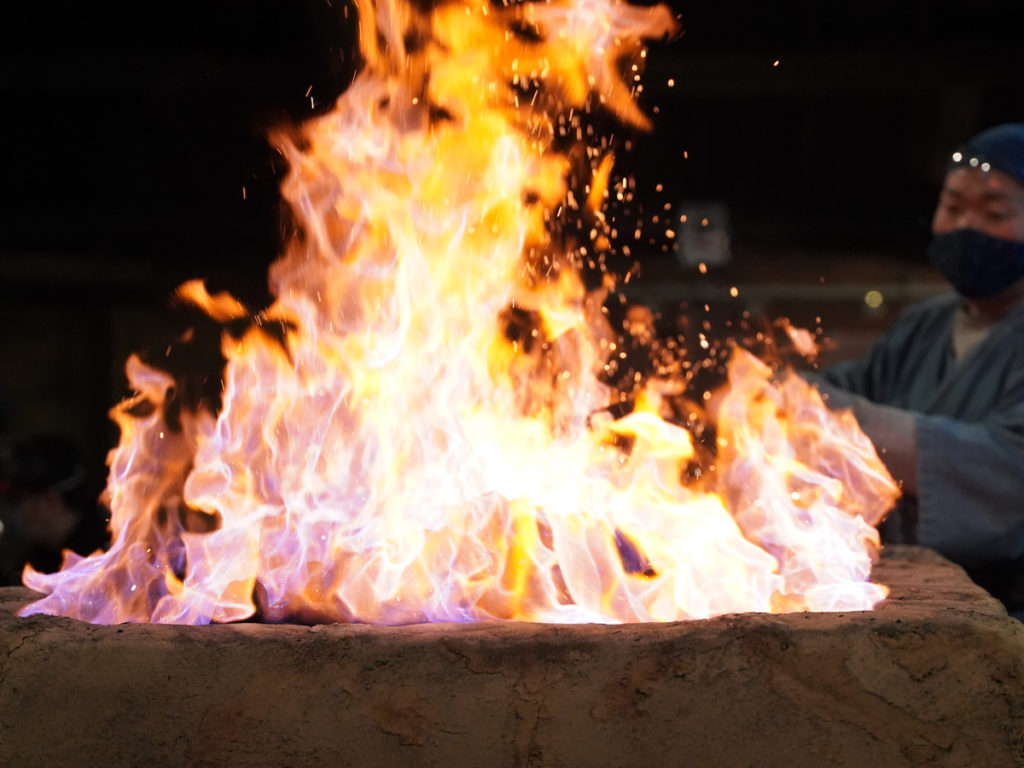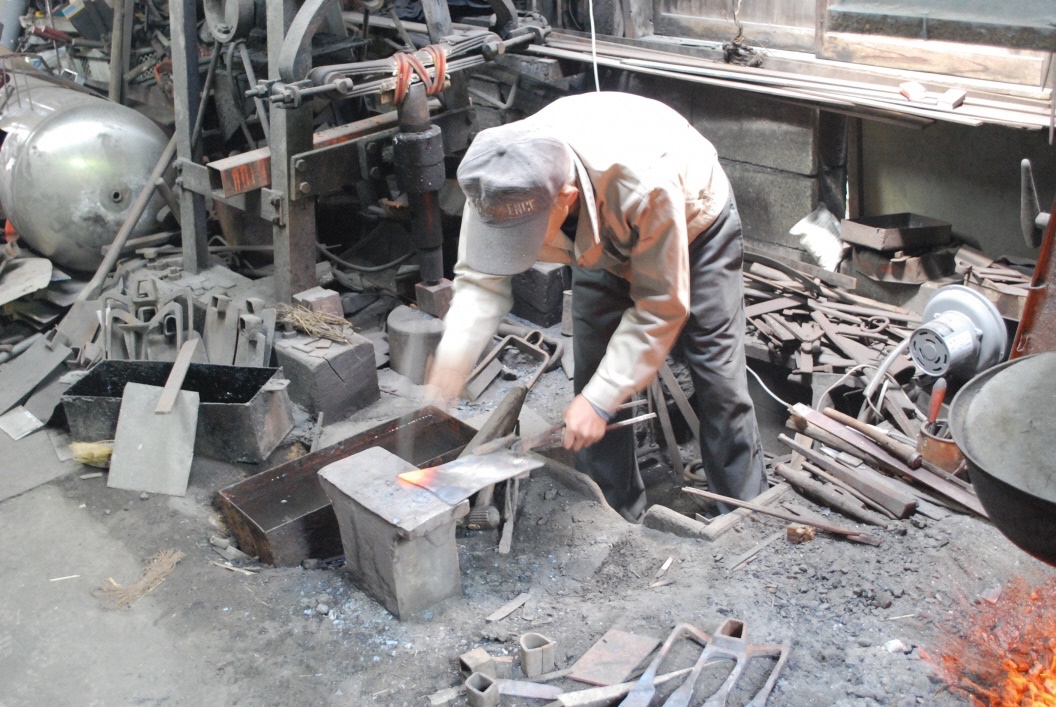What is TATARA Ironworks?
Tatara ironworks is a traditional method for smelting iron composites via simultaneous combustion of iron-sand and charcoal. This method remains the only method that can produce Tamahagane, a special type of steel used for sword crafting, even to this day.
Tatara ironworks had long been operated around the Chugoku Mountains, as the area is abundant in natural resources conducive to ironmaking. The region is rich in granite, for example, which contains high-quality iron-sand. The large areas of forests also allowed for an ample charcoal supply required in the smelting process during ironmaking. This region once flourished as a center of iron production. At its peak, between the late Edo period and early Meiji period (late 18th century to the 19th century), 90% of total domestic iron production took place in this region. The town of Yoshida, Unnan City, was the home of the Tanabe family; it was the most influential business family in the Tatara business in this region. The Tatara workshop operated by this family, called Takadono, is no longer in operation. However, their facility is the only surviving example of Takadono in Japan and is now open to the public.

Inheriting the Expertise
Iron-sand Extraction
Iron-sand used for the Tatara operation was extracted manually by a mining method called Kanna-nagashi. In this method, pickaxes were used to scrape off the topsoil of hillsides, which dislodged the soil containing iron-sand; the dislodged soil was then poured into a sluice and flushed down to a screening site. At the site, the iron-sand was refined and finally collected using the gravity concentration method. The iron-sand was sourced from not only the mountains but also from the riverbed of the Hii River.

Charcoal Making


The flame temperature during the operation had to be maintained as high as 1,300–1,500 ℃. Thus, it was essential to dehumidify and isolate the furnace from any moisture that may rise from the ground, to avoid phreatic explosions. For the purpose, large scale underground structures were constructed to keep the furnace bed dry. The construction methods were secrets of Muraghe, and each region had different characteristics.

Iron Produced by TATARA Operation
The large amount of ferrous composite produced by the Tatara operation is called Kera. Kera was carried into a workshop called Dohba, being crushed into smaller pieces, and was sorted based on quality. The hardest and finest quality steel of Kera that contained the least amount of carbon, was called Tamahagane. It was mainly used for crafting Japanese swords. The relatively low quality components were called Zuku and Bukera, which were forged into flat bars called Wari-tetsu (or Hocho-tetsu) after decarburization at the Oh-kajiba workshop. The Tanabe family’s historical records suggest that the total output of steel remained at approximately 20% of the entire production at Sugaya Tatara, with Zuku and Bukera making up the remaining 80%.
《Ironmaking Process》
| Furnace Making | Build a furnace using a specially mixed high-quality clay over the furnace bed created by rammed ash. | |
| Ironmaking | Day1 | Begin the operation: Fire up the furnace to dry it out, then pour iron-sand into the furnace. As Kera begins to form, the operation becomes stable. |
| Day2 | Kera continues to increase. More iron-sand and charcoal are charged. | |
| Day3 | Continued addition of iron-sand and acceleration of air supply. Discharge of unwanted slag and termination of iron-sand addition. | |
| Day4 | Demolish the furnace and remove Kera once the air supply is stopped. | |
Blacksmithing
Tatara ironworks required two different types of blacksmithing. Oh-kaji is a process to remove impurities from Zuku and Bukera, to produce Wari-tetsu (Hocho-tetsu) through decarburization and forging. Tanabe family used to own Oh-kaji workshops close to their residential property, since Wari-tetsu (Hocho-tetsu) was their primary product for their business during the late 17th century. On the other hand, forging kitchen knives, farming, and carpentry tools were called Ko-kaji, which used Wari-tetsu (Hocho-tetsu, meaning kitchen-knife iron) as the crafting material. Japanese swordsmithing is a type of Ko-kaji.


TATARA Industry and its Prosperity in Unnan Area
Unnan area lies in the water basin of the Hii River that runs through the city from south to north. Its prosperity was attributable not only to ironmaking, iron-sand extracting, charcoal making, iron distribution, and crafting of iron products, but was also supported by agriculture, forestry, and commercial activities. Many markets were held here; the flow of people and products created vibrant atmospheres. Especially, Kisuki Town in Unnan City flourished as a centre of iron distribution and blacksmithing. Rice threshers, known as Kisuki Senba, were made in Kisuki Town; these were popular and were sold nationwide.

Ironmaking Policy in Matsue Domain
Iron produced by the Tatara operation had become a specialty of Izumo Province during the Edo period. It was highly valued as a primary industry by Matsue Domain, which governed the region. The ironmaking industry developed under the patronage of Matsue Domain by the setting a protection policy by the Domain over the industry and restricting the number of Tesshi to assure them enough natural resources for ironmaking. Thus, their outputs increased and were distributed all over Japan as iron became the common material for making products of daily use that supported society’s development during the Edo period.
Japan’s Heritage: ‘Izumo Tatara Chronicle, A Thousand Years of Iron’
Although the Tatara ironmaking industry terminated a hundred years ago, the art and expertise are still alive and vibrant today. A group of tangible and intangible cultural heritages associated with Tatara ironworks that remained in Unnan City, Yasughi City, and Okuizumo Town are accredited as Japan’s Heritage of ‘Izumo Tatara Chronicle, A Thousand Years of Iron’ by the Agency for Cultural Affairs in 2016.







